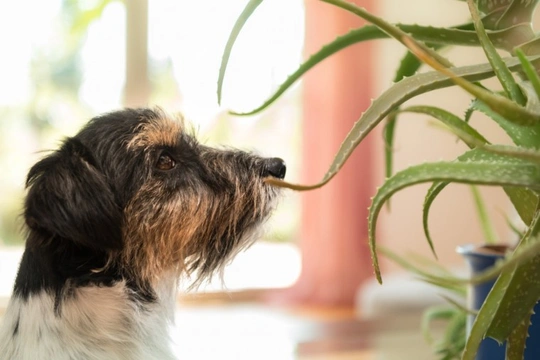
Did you know that aloe vera is toxic to dogs?
Aloe vera is a very familiar word for most of us, and keeping aloe vera plants is almost as popular as buying and using products made from aloe vera.
Aloe vera comes in a huge range of different forms, including gels, liquids and as an ingredient in things like shampoo, cooling first aid sprays, and much more; in fact, aloe vera is for many people a go-to staple cure-all for lots of things, from skin irritations to minor burns.
You can even buy aloe vera juice drinks as a health supplement, although the jury is still out on whether or not they taste very nice!
Given how common and widely used aloe vera is for many things and that fact that you can even buy drinks containing it, it comes as a big surprise to many dog owners to learn that aloe vera is toxic to dogs!
Whilst far from being one of the most acutely dangerous poisons a dog might ingest, aloe vera is certainly not something you should encourage your dog to eat or drink, or use on their body where they might lick it off.
If you didn’t know that aloe vera is toxic to dogs, you’ll probably want to know more about how, why, and what effect aloe vera has on dogs; and we’ll cover all of these things and more within this article.
Read on to learn more about aloe vera and how it affects dogs.
What is aloe vera?
Aloe vera is a succulent plant that is sold both as a decorative plant and for its perceived health benefits; usually pertaining to the clear gel that can be found within the aloe plant’s leaves if you cut them open.
This gel is sold in various formats commercially, and many people also keep aloe plants to cut fresh too.
What makes aloe vera toxic to dogs?
There is a chemical within aloe vera called saponin, which leads to toxicity and the potential breakdown of red blood cells if ingested, which can be fatal. Saponin bonds to sugar on a molecular level, affecting the dog’s blood sugar and once more, this can be very dangerous and even fatal.
Aloe also contains anthraquinone glycosides, which have a powerful effect on the bowels that can result in uncontrolled diarrhoea and associated dehydration.
The latex, which is the inner skin of the aloe vera leaves, is the part that contains the powerful natural laxative that can cause dehydration from the diarrhoea it can cause. It is also apt to generate very painful stomach cramps and discomfort in your dog.
What part of the aloe vera plant is toxic to dogs?
Whilst aloe vera is safe for topical use as long as you can keep your dog from licking it, it is not wise to allow your dog to ingest any part of an aloe plant, nor to eat the gel.
However, the key danger posed to dogs by aloe vera plants comes from the inside skin of the aloe’s leaves, which is called “latex,” and it is this that contains the saponin, which is dangerous to dogs if ingested.
What are the symptoms of aloe vera toxicity in dogs?
If you keep an aloe vera plant at home, keep it out of reach of your dog as dogs explore the world with their mouths and some will chew plants and leaves, even if they don’t taste particularly good!
If your dog does eat aloe vera and particularly, if they’ve ingested the latex or inner part of the leaves, the symptoms they display can be variable depending on how much they ate and how it affects them.
Signs of aloe vera toxicity in dogs to look out for include:
- Pain in the stomach region, with the stomach potentially being bloated and/or hard to the touch.
- Breathing difficulties, or fast, shallow breathing.
- A faster than normal or erratic heart rate.
- Refusal of food.
- Very orange or dark-coloured urine.
- Lethargy and loss of interest in exercise.
- Diarrhoea, often acute and severe.
- Vomiting, again often acute.
- A high temperature.
- Trembling or weak limbs, problems standing up.
- Loss of coordination or an inability to stay upright, potentially staggering around.
- Drooling and slobbering, with or without vomiting.
- Dilated pupils (pupils that are overly large for the lighting conditions).
- Aloe vera poisoning in dogs can ultimately result in coma.
How dangerous is aloe vera to dogs?
Aloe vera poisoning in dogs will cause only mild to moderate symptoms in most dogs, and it is widely regarded as one of the less dangerous toxic plants a dog might ingest, particularly when they don’t ingest any of the latex part of the plant.
Acute and potentially life-threatening symptoms in dogs are fairly uncommon and most dogs will recover from aloe vera toxicity, but they may need treatment to achieve this; so always contact your vet if you know or suspect that your dog has ingested aloe vera.



